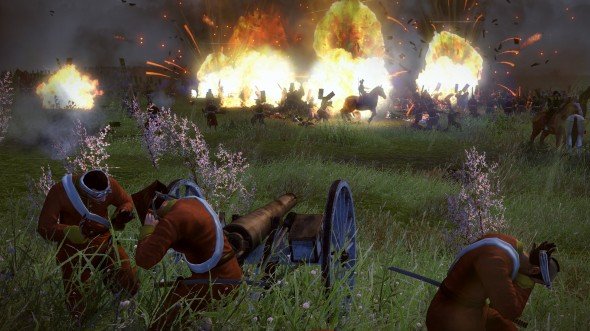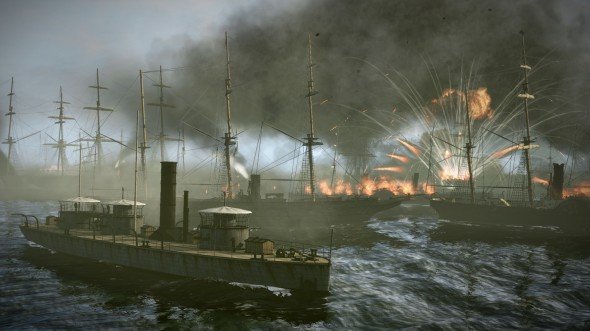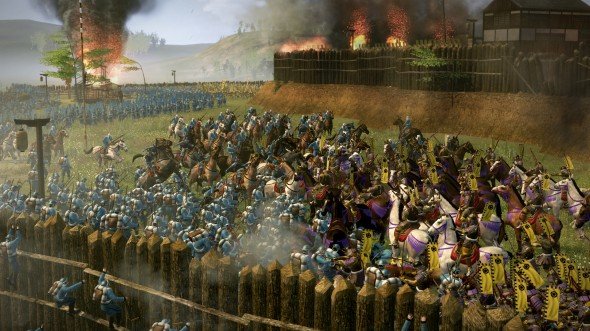
With only a day to play the surprisingly polished alpha build, I didn't have time to hoof through the full quarter-century of a long campaign, but I did – via a save file – get a tantalising taste of late-game politics and army compositions. Rather than gleefully dissolving all your carefully cultivated alliances and forcing you into a gruelling multi-front struggle for survival, Realm Divide in Fall of the Samurai involves making a difficult choice. If you fancy it, you can leave the Shogunate and Imperialist factions to fight amongst themselves and go it alone as a friendless independent republic. Alternatively you can accept the responsibilities and regalia of Shogunate or Imperial 'Vanguard' (the choice will depend on your current allegiance). Take the latter route and you're guaranteed some continuity of support. You may even be able to persuade some old enemies to bury the hatchet for the common good.
By the time of Realm Divide, it's likely your troops will be doing most of their slaying with fancy Westerndesigned rifles and artillery pieces, rather than cold steel and arrows. The shooting irons used by Ruritanian wonders like White Bear Infantry, Royal Marines and Kiheitai riflemen fire further and faster, and are far more likely to hit what they're aimed at than the fusty muskets of Empire and Napoleon: Total War. The increased reach and lethality of line units means that tactics that produced victories in Shogun 2 may well produce valedictions in Fall of the Samurai.
Chatting to James Russell (lead designer) and Jamie Ferguson (lead battle designer) about the re-education of the tacAI, the pair talked of the work that has gone into honing its threat awareness, (specifically in relation to fields of fire), decisiveness, and use of such manoeuvres as flanking and – gulp – double envelopment. Artificial opponents have had special lessons in Not Acting Like Pillocks When Faced With Gatling Guns, so hopefully, we shouldn't see too many Last Samurai style frontal assaults.
Improvements in naval nous sound even more substantial. Lead campaign designer Janos Gaspar described how computer-controlled admirals now have a much more sophisticated understanding of geography and, thanks to a new taskforce system, are much better at setting up fleets and dealing with several tasks simultaneously. Expect to see enemy shipping sagely switching from blockades to bombardments, and dashing off to help with troop transportation when the need arises.

Away from battlefields and brine, Creative Assembly have actually been lobotomising their AI. Apparently, in the current build, silicon powers are far too efficient at managing their economies and will routinely outproduce most players by 30-35%. When James cheerfully admitted that they would have to “cheat in favour of the player” I remembered my two campaign false-starts earlier in the day and nodded enthusiastically.
In the unlikely event Fall of the Samurai's reworked AI fails to stretch you, then a couple of series additions will allow for some self-imposed challenge stiffening. Winning every engagement with a mix of inspired tactics and encyclopedic knowledge of unit stats? Try Battle Realism Mode's restricted camera, absent minimap, and limited enemy intel. Alternatively, make life hard for yourself by handing over a few units to the AI. Not only is it now possible to participate in 40 vs 40 unit scraps thanks to an altered approach to reinforcements, but packets of troops can be passed to the AI together with simple 'attack' or 'defend' instructions. Is this the first step on the road to multi-tier Take Command-style armies and plausible battlefield subordinates? Probably not, but it's an intriguing development.
Tight-lipped on the topic of future Total War directions, James, Jamie and Janos were happy to talk about inspiration and research. If you want to know why Fall of the Samurai looks, feels and plays the way it does, then a good place to start is the book list on www.stephenturnbull.com. An evening with Japanese movie When The Last Sword Is Drawn should also prove illuminating.
The biggest gaming news, reviews and hardware deals
Keep up to date with the most important stories and the best deals, as picked by the PC Gamer team.
The game's relationship to The Last Samurai is – as previously mentioned – not nearly as close as it might first appear, but the devs have obviously pored over its action sequences. Satsuma Rebellion-style revolts will happen now and again, meaning players will find themselves leading expeditions into the back-country to suppress armies of disgruntled nobles. The samurai sprinting stirringly through storms of machinegun and rifle fire are far more likely to be reactionary foe than valued friends.

In Fall of the Samurai's brave new world, almost everyone hates change. The simple act of shinning-up the tech tree increases your Modernisation Level which in turn stokes popular disquiet. Going by our playtest, it's not food shortages or even occupation resentment that will be your biggest civic headache in this instalment, it's a disoriented populace that longs for the days when sunsets weren't smudged by factory smoke, picturesque valleys haunted by noisy, impatient dragons.
As your lands lurch into modernity, so too will the interface, the campaign map and the background music. The sounds of traditional Japan will slowly and subtly give ground to Western instruments and motifs. Screen furniture will assume a more mechanized look. A completely reorganised campaign map, graced by new loftier peaks, will acquire smokestacks and smoggy blemishes. Total War is knocking on the door of the 20th century, and that door is soot caked and strange.
As historical themes go, it's hard to think of one fresher or more alluring than Boshin War-era Japan. Cynics may point out that the real conflict 'only' claimed the lives of 4,000, that it featured more nervous scuffles than full-scale pitched battles, but this would be a tad unfair. As Jamie observed: “with all Total War games we start with a factual startpoint then allow for counter-factual history to take place... There's nothing to say that, if either side had decided to get really serious, it couldn't have ended up in a conflict far more bloody than the American Civil War.”
A conflict far more bloody than the American Civil War? With Total War's unit counts that could be a tall order, but then again, with Gatling guns, naval barrages and repeating rifles in our armouries for the first time, anything's possible.

